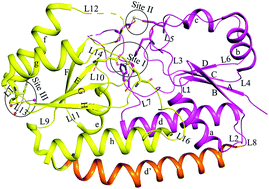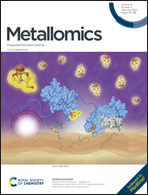Characterization of the heavy metal binding properties of periplasmic metal uptake protein CLas-ZnuA2†
Abstract
Candidatus Liberibacter asiaticus (CLas), a phloem-limited unculturable Gram-negative bacterium, causes citrus greening disease. The proteome analysis of CLas showed the presence of a heavy metal permease and Co/Zn/Cd cation exporter system. However, there is no designated metal uptake protein specific for the heavy metal permease in CLas. One of the metal uptake proteins, designated as CLas-ZnuA2, in our previous studies, showed a lower metal-binding affinity for Mn2+ and Zn2+ and was postulated to bind and transport metals rather non-specifically. The present study focused on the characterization of the heavy metal binding properties of CLas-ZnuA2 using SPR, CD, DSC and crystallographic studies. The crystal structure analysis of Cd2+ bound CLas-ZnuA2 showed octahedral geometry for Cd2+ binding as compared to a non-preferred square-pyramidal geometry for Mn2+ and Zn2+ binding in earlier reported crystal structures. In SPR analysis, the binding affinities of 4.7 × 10−6 M, 7.2 × 10−6 M, 5.3 × 10−5 M and 4.3 × 10−5 M for Hg2+, Cd2+, Ba2+ and Co2+ respectively were higher as compared to earlier reported values for Mn2+ and Zn2+. Likewise, CD and DSC analysis showed relatively higher thermal stability for CLas-ZnuA2 on heavy metal binding. Taken together with the expression of the permease and exporter system for heavy metals, our results indicate that CLas-ZnuA2 may be involved in sequestering and transport of various transition divalent metals in environmentally stressed conditions.



 Please wait while we load your content...
Please wait while we load your content...